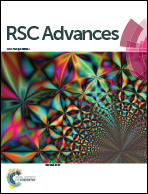Nutrient removal and microbial mechanisms in constructed wetland microcosms treating high nitrate/nitrite polluted river water†
Abstract
In rivers, nitrate/nitrite concentrations often vary with seasons and locations, and excess nitrogen can cause eutrophication. Constructed wetlands (CWs) have been used as a typical and optimal ecological technology to purify river water. In the present study, nitrogen (N) removal and related microbial mechanisms of treating high nitrate/nitrite polluted river water were explored in CW microcosms. Excellent removal performances were simultaneously achieved with low and stable effluent concentrations of NO3−–N (0.29–0.51 mg L−1), NO2−–N (0.65–1.0 mg L−1), NH4+–N (0.18–0.40 mg L−1), and TN (1.24–1.56 mg L−1) in our experimental and control groups. Based on the mass balance approach, plant uptake eliminated 11–14% of the total N input and sediment storage contributed 5–11% of N removal, indicating assimilation into biomass and sediment might be important sections of N removal besides microbial nitrification and denitrification. According to the 16S rRNA gene sequencing results, nitrate had positive effects on microbial community richness and diversity. Proteobacteria were particularly identified to be the dominant bacterial strains involved in N transformation in CWs and accounted for 37.26–52.99%. The relative abundance of Proteobacteria was highest after adding nitrate. Gamma- and beta-Proteobacteria were probably responsible for nitrate biodegradation. Bacillus and Cyanobacteria were speculated to be responsible for N removal and transformation. Overall, the results in this study could provide suggestions for treating high nitrate/nitrite polluted river water.


 Please wait while we load your content...
Please wait while we load your content...